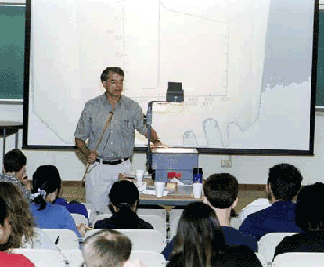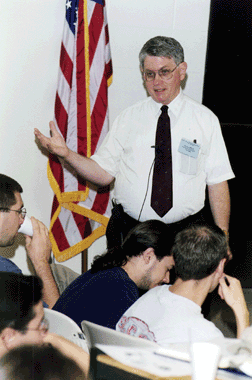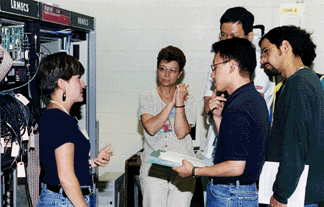During the two-week period of August 14-26, 2000 Argonne National Laboratory once again hosted the National School on Neutron and X-Ray Scattering funded by the Office of Basic Energy Science of the Department of Energy. The success of the school last year was so overwhelming that additional funding was provided by DOE to increase the size of the school from 48 to 60 graduate students. Additional funding for the school was also provided by the Spallation Neutron Source Long Wavelength Target Station Conceptual Design Project through the University of Tennessee and the National Science Foundation. The school fulfills a continuing need in training graduate students in the utilization of national user facilities and it is our intent to offer this course at Argonne in the future. To that end, many students from the previous school are currently utilizing national user facilities not only at ANL, but throughout the country.
The school accepted 60 students out of 160 applicants, with a wide geographical, academic, and demographic distribution. Students came from twenty-four states plus the District of Columbia. The students came from a wide range of academic backgrounds: 19 Ph.D. candidates in physics, 18 in chemistry, 14 in materials science and nuclear engineering, 6 in chemical engineering and 3 in biological and environmental sciences.
The formal part of the program included 32 hours of lectures given by an internationally known group of scientists who were recruited from universities, national laboratories and industry.
The scope of the school was formative with a robust background of scattering theory presented by Sunil Sinha, as well as lectures given on X-ray instrumentation (Michael Hart) and neutron instrumentation (Tom Mason). Jim Rhyne spoke extensively regarding access to neutron facilities in his role as the President of the Neutron Scattering Society of America. Gene Ice, following with a presentation illustrating the capability of and access to various synchrotron light facilities, burst into song ("Ballad of the X-ray User") - complete with guitar accompaniment - to the delight of the audience. Other plenary lecturers included: J. M. Gibson, S. Heald, B.C. Larson and C. Majkrzak.
The hands-on portion of the school was quite extensive. The students had extensive tours of the Advance Photon Source and Intense Pulse Neutron Source which were followed by experiments at these facilities. The experiments were designed to demonstrate the diverse properties of neutrons and X-rays as manifested by scattering experiments. The program of the school included experiments in either "soft matter" (neutron reflectivity, small angle neutron scattering, and EXAFS), in "materials science" (neutron powder diffraction, standing waves and X-ray reflectivity) and solid state physics (single crystal X-ray diffraction, inelastic neutron scattering and inelastic X-ray scattering. Implementing the practical aspects of the program for 60 students was an enormous coordinated effort. More than forty instructors, not only from the Advanced Photon Sources, the Intense Pulse Neutron Source, Materials Science and Chemistry Divisions but also from several Collaborative Access Teams (CATS) and the Spallation Neutron Source generously provided their time and expertise.
We are proud to report that from all indications, the students ranked the components of the school quite favorably and indicated their intention of returning to ANL or other national user facilities. Gian Felcher and Dennis Mills, the founding Scientific Directors of the NX School, have passed on this responsibility to Ray Osborne and Dean Haeffner respectively. We wish the new directors similar success and good fortune in this endeavor
Bruce Brown, Gian Felcher, Dennis Mills, and Harold Myron - Argonne National Laboratory



